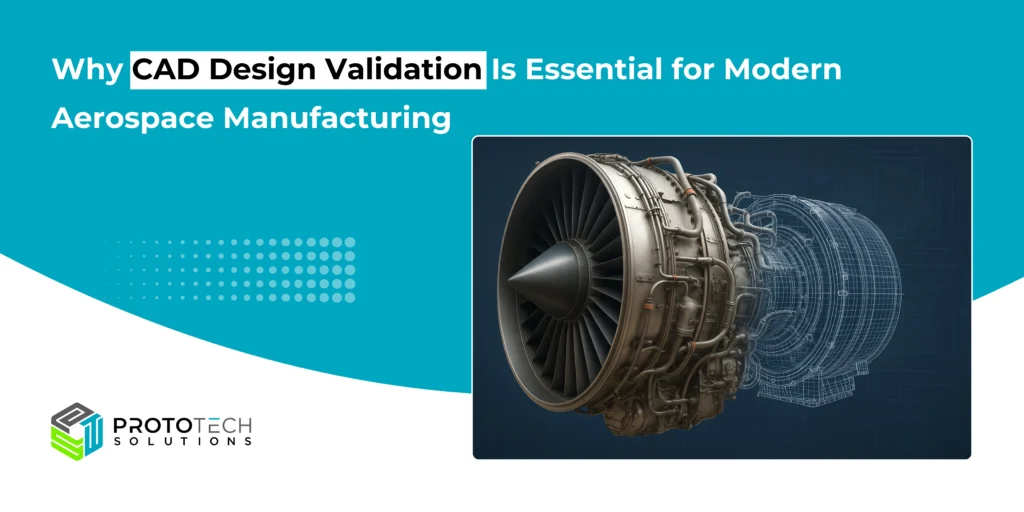Why CAD Design Validation Is Essential for Modern Aerospace Manufacturing

In today’s highly competitive aerospace industry, the margin for design errors has grown slimmer than ever. With aircraft safety, performance, and compliance on the line, manufacturers cannot afford mistakes in their product development process. This is where CAD Model Validation for Aerospace plays a transformative role. By ensuring that every design is accurate, compliant, and production-ready, CAD validation acts as a safety net, catching critical issues before they take flight.
But why is design validation so crucial in modern aerospace manufacturing, an industry already known for its precision and innovation? Let’s uncover the real reasons.
The Rising Complexity of Aerospace Manufacturing
Modern aerospace systems are not just machines; they are marvels of engineering, blending aerodynamic efficiency, sophisticated electronics, and advanced materials. Every aircraft today consists of millions of individual parts and assemblies that must function in harmony under extreme conditions.
If even a single part fails or is manufactured with design data errors, the outcome could be disastrous. That’s why aerospace manufacturers are increasingly relying on CAD design validation tools to ensure seamless accuracy at every stage of the product lifecycle.
While CAD modeling has enabled better visualization and faster prototyping, without validation, design files leave room for:
- Geometry errors in 3D models
- Incorrect tolerances and material specifications
- Misalignments in assemblies
- Non-compliance with aerospace industry standards like AS9100
CAD validation ensures that these issues are caught early instead of showing up much later during physical testing or worse, after deployment.
What Is CAD Model Validation in Aerospace?
CAD model validation refers to the process of cross-checking, verifying, and ensuring that 3D digital designs meet the required specifications, standards, and compatibilities before moving into the manufacturing phase. It acts as a bridge between design intent and production reality.
This process usually includes:
- Geometry validation: Checking for gaps, overlaps, and inconsistencies.
- Tolerance analysis: Verifying part dimensions for manufacturability.
- Standards compliance check: Ensuring designs align with AS9102, ISO, and industry interoperability formats.
- Data exchange validation: Confirming accurate translation of models between different CAD and PLM systems.
Essentially, validation transforms a digital prototype into a certified, manufacturing-ready design that can be trusted at scale.
Why Errors in Aerospace Design Are Costly
The aerospace industry operates under unforgiving circumstances. Even the smallest design slip-up can lead to:
- Massive financial loss: A redesign late in production can result in millions of dollars in wasted materials and labor.
- Delayed project timelines: Undetected CAD errors often push delivery schedules back by months.
- Failure in compliance audits: Aerospace authorities demand strict design and manufacturing traceability. Missing validation can cause certification rejections.
- Safety risks: In airborne systems, design defects can directly endanger human lives.
This is why manufacturers are shifting focus from simple CAD modeling to CAD validation, integrated workflows that directly minimize these risks.
Benefits of CAD Model Validation for Aerospace
Now that we understand the risks of neglecting validation, let’s highlight the competitive advantages aerospace companies gain from adopting robust validation practices:
- Design Accuracy: Ensure every model feature and dimension is correct.
- Process Efficiency: Detect and resolve errors in digital models—before they move to costly machining and assembly.
- Interoperability: Make sure designs are accurately translated between platforms like CATIA, Siemens NX, and SolidWorks.
- Regulatory Compliance: Confidently meet FAA, EASA, and AS9100 requirements.
- Innovation Acceleration: Free up engineering teams to focus on new designs instead of fixing downstream issues.
How Digital Twins and Validation Work Together
One of the most exciting evolutions in aerospace design is the adoption of digital twins. These virtual replicas of physical systems inherently rely on flawless CAD data. Without validation, a digital twin may be misrepresentative, leading to inaccurate simulations of flight performance or maintenance cycles.
By combining CAD model validation with digital twin strategies, aerospace companies can get a 360-degree, trustworthy view of aircraft performance. This not only enhances product safety but also creates long-term value in predictive maintenance and lifecycle cost management.
Real-World Consequences of Skipping Validation
Take the Boeing 787 Dreamliner program, for example. In its early stages, suppliers and engineering teams faced issues with CAD data translation and model inconsistencies. Small misalignments in digital models led to larger assembly problems on the production floor. The result? Delays that cost billions of dollars and pushed back delivery schedules by more than three years.
Another case: the NASA Mars Climate Orbiter (1999), although not strictly a CAD validation failure, highlights the dangers of unchecked design assumptions. A mismatch between metric and imperial units in design and simulation data caused the $125 million spacecraft to burn up in the Martian atmosphere.
At ProtoTech Solutions, we developed advanced CAD Interoperability software for our client, TransMagic. The TransMagic tool has been successfully used in Boeing Spec D6 51991 projects, helping aerospace manufacturers meet the stringent AS9100 compliance standards. This real-world application proves how the right validation and interoperability solutions can empower aerospace companies to innovate with confidence.
Discover how our CAD validation solutions guarantee reliability, traceability, and unparalleled quality essential for modern aerospace manufacturing success. Contact ProtoTech to elevate your design quality and compliance today.






